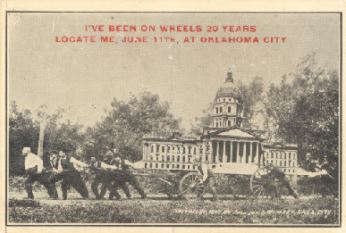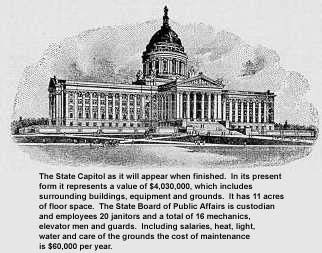
OKLAHOMA CAPITOL
The Dream
It was a fitting birthplace for Oklahoma's State Capitol, a wind-swept parcel of prairie claimed during the Land Run of 1889 when, in a span of one day, thousands of itinerant settlers pitched their tents in what would become Oklahoma City.
When J. J. Culbertson and W.F. Harn became owners of property claimed during Oklahoma's Land Rush of 1889, they never dreamed the corners of their pastures would one day hold the Oklahoma State Capitol. In fact, the odds were against the capitol being built in Oklahoma City at all.
Even today, the mere mention of the selection of Oklahoma City as the state capitol over the territorial capitol of Guthrie in 1910 may still inflame tempers and invite debate. Rumors of the removal of the state seal from the temporary capitol of Guthrie under the cover of night, scathing newspaper editorials, and questionable elections add intrigue to the urban legends surrounding the choice of Oklahoma City as the state capitol.

1910 Postcard-Oklahoma Historical Society
The city of Guthrie led a spirited campaign to retain its role as the capitol city into statehood, but Oklahoma residents and the legislature were not persuaded. A statewide election and a special session vote of the Oklahoma Legislature on December 16, 1910, officially declared Oklahoma City the permanent state capitol.
Construction planning followed, and groundbreaking ceremonies occurred on July 20, 1914. The capitol was ready for occupancy three years later when construction was completed on June 30, 1917.
Architectural Classic
Classic Greek and Roman architecture visited the Oklahoma prairie when the firm of Solomon Layton and S. Wemyss Smith was chosen to design the state capitol. Layton, the capitol's visionary lead architect, conceived his plans in accordance with the Greco-Roman, or neoclassical style.
Layton perched eight winged lions--symbols of the continual struggle of regal dignity and victory--atop the building's roof. The four-ton cornerstone, composed of granite came from Tishomingo, Oklahoma and holds fifty historical documents from that time.
The capitol's imposing exterior is made up of Indiana limestone complemented by a base of pink granite quarried from the southern Oklahoma town of Troy. Floors throughout the capitol are made of Alabama marble; Vermont marble adorns the wall bases and stairways. Black granite from Cold Springs, Oklahoma forms the outside steps and tables along the Grand Staircase.
Residing on fifteen acres of land and housing 650 rooms the completed capitol in 1917 cost 1.5 million dollars, approximately twenty-five cents per square foot. One key element, however was missing.
A Capitol Uncovered
The original designs called for a dome to be built on the state capitol, but Oklahoma's house of government remains one of only twelve capitols in the United States without a dome. Oklahoma's capitol holds the distinction, however, as the only state capitol designed to have a dome that was never built.
Of all the hurdles faced in doming the capitol, World War I shares the bulk of the blame. Oklahomans hoped after the war a dome would be built, however shortages led the price of materials to skyrocket, so much that the cost of constructing a dome by war's end would have been nearly that originally invested to build the entire capitol.

Artists rendering of the anticipated Dome-1921
To the dismay of purists, the dome never took shape, but the idea of a dome was not abandoned. Compensating for the unfinished look of the capitol ceiling without the dome, designers turned to special effects. A saucer dome was constructed to give the appearance of a shallow dome from the interior. In 1934, the State Seal of Oklahoma was inlaid in the ceiling, enhancing the faux dome effect.
The Vision Completed
More than eighty years later, it is only fitting that the dome be raised in time for Oklahoma's second century of statehood. Starting in 1999, the State Capitol Complex and Oklahoma Centennial Commemoration Commission successfully carried out a fundraising campaign to build the dome. A combination of private and public monies was raised to bring Solomon Layton's vision to reality.
(Click Program)
Historic Dome Raising Ceremony - June 20, 2002
![]()
©2001-2004 Linda Simpson
![]()
08/02/2015